"INTERVIEWS
I first interviewed Gale Bennett because of his familiarity with the Mountain Home Range through his work for the BLM since 1973. Gale was the first to tell me of the Pegleg Smith-Walkara story. He had read about the story in the book, "Claw of the Hawk". He later came upon the book "0ld Spanish Trail", which confirmed his theory of where the horses came from. Gale believes that the horses were brought into the area by the Ute Indians. Not only from Walkara's exploits, but also from the Ute's hunting and gathering pine nuts in the area. During helicopter flights,.Gale has seen circular rock pits, 35 to 50 feet in diameter, and in a row . He says these were use by Indians to cook the pinion pine cones from which the pinion nuts were used for food. He has also seen many arrow head chippings in the area.
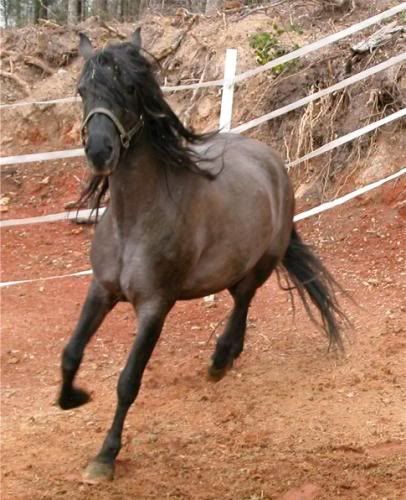 BR Lakota's Dreamweaver
BR Lakota's DreamweaverI asked Gale if there was a difference in the Sulphur horses compared to those horses from other herd management areas. He said that they are a little bit smaller and more intelligent; they are afraid of people when first caught, but gentle down quick and accept people quicker than horses in other areas; and they are built stronger than other horses and have nicer heads. I asked if there were many dun factor horses in the other herds in Utah. He said, "No, that's one definite difference, at least in that bunch, is the coloring, of the buckskin (line backed), the dun, and the grulla, and that, we do not have in any other areas."
Glenn Foreman had told me that the Sulphur horses were wiser than horses in other herd management areas and were therefore harder to catch. I asked Gale about this and he said, "I think they are in an area that's harder to trap more than they are hard to trap. They're in an area where there's juniper- pinion.trees just so thick. The terrain, the timber, the country there is just definitely harder to trap horses in."
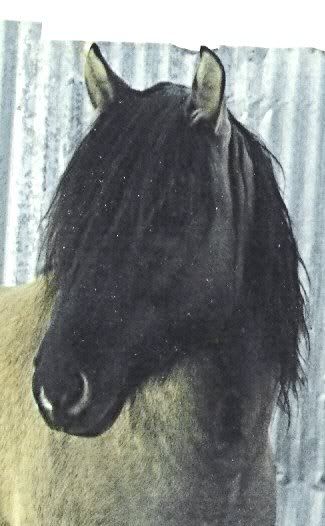
Craig Egerton told me, he noticed that when the horses are first caught, branded, and worked on, they sulk, lay down, and actually make a whimpering sound. This, to me, seems to be a typical reaction to captivity of an animal that exhibits a truly wild behavior. He also said that he heard that mustangers and local people left the horses alone because of their color and uniqueness. He told me of four Pryor Mountain horses that were put in with the Sulphur horses years ago. The Sulphur horses wouldn't accept them and the Pryor Mountain horses ran alone, at least for the years that the BLM could keep track of them.
Kent Gregersen, from Marysvale, Utah, first went into the Mountain Home Range in 1944, when he was fourteen years old. Kent became a mustanger in later years and caught many horses out of the area. He did a lot of mustanging in Nevada and Utah, where he caught and sold many horses. Kent recognized there was something unique about the Mountain Home horses, and after catching some, had them inspected by Bob Brislawn, founder of the Spanish Mustang Registry. These horses were confirmed as Spanish and were registered in the registry. Kent said that Bob Brislawn traded three horses for a buckskin-colored, line-backed Mountain Home stallion he had caught. This stallion was named Doby. Dr. William Stabler, president of the SMR, wrote to me and said he was the one that inspected Doby for registration. Marye Ann Thompson, registrar for the SMR, sent me some photos of Doby, and he looks typical of the Mountain Home horses. Kent told me that the only horses that he ever kept during his mustanging years were those from the Mountain Home Range: "They were a more intelligent horse, had more speed, and more cow savvy."
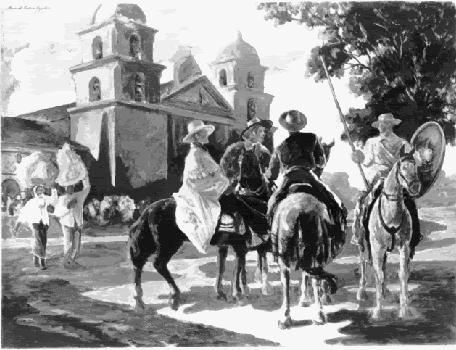 Painting of 1700's Spaniards and their horses in southern California.
Painting of 1700's Spaniards and their horses in southern California.Kent says that from the late 1930s to the early 1950s there were from 3,000 to 4,000 wild horses in the area, and most were caught by mustangers for the meat market. He said that many ranchers put domestic horses in with the wild ones to try to increase the size of the horses through cross breeding, but: "The little mustang studs would kill the domestic' stallions, and those that survived didn't adapt. They got sore footed, got down in condition, and winter killed. So, there has been a retention of the old original blood lines." I asked Kent if the domestic horses could have been those that were caught out in the early days, and the Spanish type horses, which were isolated in the mountains, were left undisturbed. He said, "Definitely." He also said the domestic horses would not mix with the Spanish type horses.
In Minersville, Utah, I interviewed 81 year old Cheryl Carter, 74 year old Daisel Davis, and 63 year old Nole Wood. Cheryl Carter said that the horses have been there all his life, and knew of no other outside horses being brought in. Daisel Davis started going into the Mountain Home Range when he was 19 years old. As far as he knows they are all Spanish mustangs, and there have never been any other horses mixed in with them. He said there have always been the buckskins and other colored horses, and a few pintos were there but they aren't there anymore. He said, "The horses have been, more or less, where nobody else is." Nole Wood also said that the horses have been there all his life, and specifically mentioned them as being buckskin with a black line down the back and having a black mane. He knew of no ranchers turning horses in with the Mountain Home horses, and felt they were pure. He said, often, that they are smarter than other horses. Nole also said his father told him that they have always been the same color, and in Pine Valley there was a thousand head of horses at one time, but the Spanish type horses were up in the hills all by themselves.
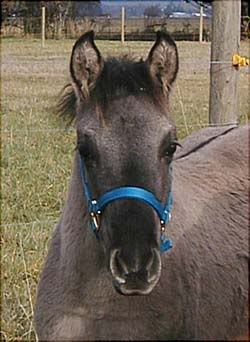 Sulphur's Corderio Riscado (Sulphur's Corderio Cruz x Sulphur's Arista)
Sulphur's Corderio Riscado (Sulphur's Corderio Cruz x Sulphur's Arista)What few people I was able to talk to in Milford, Utah, who knew anything about the horses, thought they came from the Dominguez- Escalante expedition. There is a park in Milford with a display telling about the expedition, so I'm sure that is how these people got the notion of where the horses came from.
Lad Davies is a rancher whose land is south of Garrison, Utah, in Hamblin Valley on the northwest side of the Mountain Home Range. He has been there for 63 years. He tells of draft horses being turned out with the wild horses before 1950, but none being turned out after 1950. This, he says, was an attempt by ranchers to increase the size of the wild horses. He believes that at most five percent of the wild horses bred with the domestic horses, but any cross breeding has never shown in the horses. He said, "I'd say these horses are ninety-five percent straight mustang, and I think you can go there and eyeball them, and someone that was knowledgeable could pick every one of them out, and that's my opinion." He went on to say, "These tame horses here all ran in the valley and all the wild horses ran in the mountains because the tame horses feet wouldn't stand up in the mountains, but they did mix a little, not a lot."
When I interviewed Gale Bennett, I asked for his opinion of the horses in the Sulphur unit as far as the Spanish ancestry goes? He answered, "I think these horses are the closest thing to the Spanish horses there are in the United States or in this continent, in my opinion." On the other hand, I interviewed Carl Mahon, a retired BLM employee from Montecello, Utah, over the telephone, and he didn't think there were any full-blooded Spanish horses left.
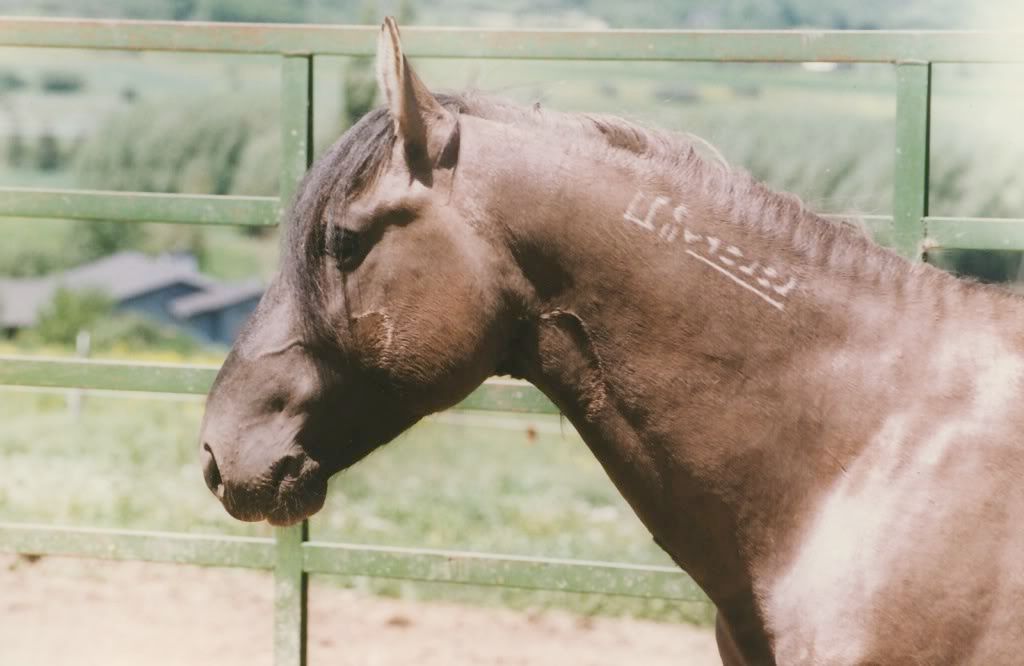 Takita
TakitaI have found, during interviews and discussing Spanish type horses with various people, that much is based on both assumption and personal opinion. Some people think a group of horses are of Spanish descent while others think not. Everyone has their own opinion, which varies as much as there are different colors in Spanish horses. It is therefore understandable that besides a history, the appearance and blood-type of the horses in question are important. Also, "in my opinion," one needs to weigh the evidence and put logic to work.
Wood also said that the horses have been there all his life, and specifically mentioned them as being buckskin with a black line down the back and having a black mane. He knew of no ranchers turning horses in with the Mountain Home horses, and felt they were pure. He said, often, that they are smarter than other horses. Nole also said his father told him that they have always been the same color, and in Pine Valley there was a thousand head of horses at one time, but the Spanish type horses were up in the hills all by themselves.
What few people I was able to talk to in Milford, Utah, who knew anything about the horses, thought they came from the Dominguez- Escalante expedition. There is a park in Milford with a display telling about the expedition, so I'm sure that is how these people got the notion of where the horses came from.
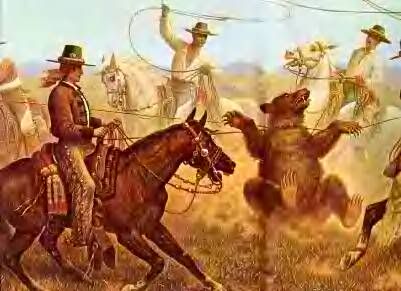 Spaniards roping a bear.
Spaniards roping a bear.Lad Davies is a rancher whose land is south of Garrison, Utah, in Hamblin Valley on the northwest side of the Mountain Home Range. He has been there for 63 years. He tells of draft horses being turned out with the wild horses before 1950, but none being turned out after 1950. This, he says, was an attempt by ranchers to increase the size of the wild horses. He believes that at most five percent of the wild horses bred with the domestic horses, but any cross breeding has never shown in the horses. He said, "I'd say these horses are ninety-five percent straight mustang, and I think you can go there and eyeball them, and someone that was knowledgeable could pick every one of them out, and that's my opinion." He went on to say, "These tame horses here all ran in the valley and all the wild horses ran in the mountains because the tame horses feet wouldn't stand up in the mountains, but they did mix a little, not a lot."
When I interviewed Gale Bennett, I asked for his opinion of the horses in the Sulphur unit as far as the Spanish ancestry goes? He answered, "I think these horses are the closest thing to the Spanish horses there are in the United States or in this continent, in my opinion." On the other hand, I interviewed Carl Mahon, a retired BLM employee from Monticello, Utah, over the telephone, and he didn't think there were any full-blooded Spanish horses left.
I have found, during interviews and discussing Spanish type horses with various people, that much is based on both assumption and personal opinion. Some people think a group of horses are of Spanish descent while others think not. Everyone has their own opinion, which varies as much as there are different colors in Spanish horses. It is therefore understandable that besides a history, the appearance and blood-type of the horses in question are important. Also,
"in my opinion," one needs to weigh the evidence and put logic to work."
As I read this post, I learned a lot of new stuff. I hope to see a full-blooded Spanish horses. I would love to experience riding at them. Thank you for sharing.
ReplyDeleteRaven
blue ridge mountain homes